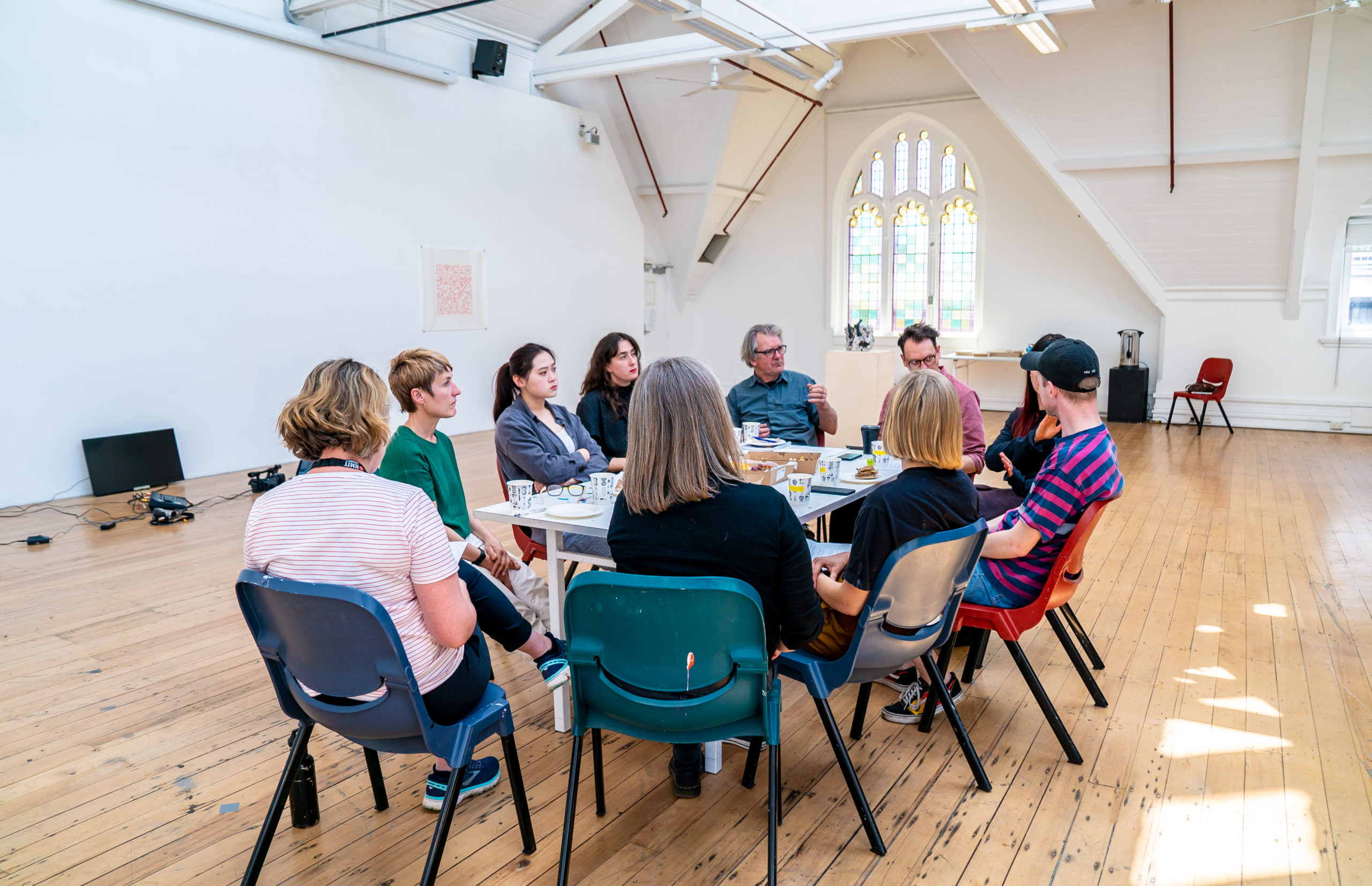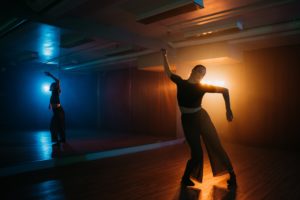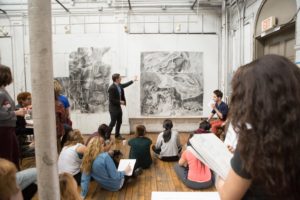Feedback and Critique in Fine Art
What to expect in group tutorials
Navigation
What Are Group Tutorials? | What is the Purpose of Group Tutorials?| Managing Nerves | Critique Not Criticism | Challenges | Positive Experiences | Models for Group Tutorials | What Happens Next? | Further Resources
What Are Group Tutorials?
A core learning activity you will encounter in almost every studio course is group tutorials. The process is vital for the development of your creative practice. Group tutorials are guided by your lecturers, but your ideas and responses lead the discussion – this helps your lecturers track your progress and development. At art school you will encounter people of different ages, cultural backgrounds, genders, and most importantly, different types of practice. These differences contribute to a rich discussion and are a chance to expand your thinking and making possibilities.
In this video we would like to share some insights and information with you about the group tutorial feedback and critique process we use in the discipline of art.
In group tutorials you can:
- Receive group feedback on how you might extend, maximize or expand your work.
- Hear ideas about how to create new works in another media.
- Listen to suggestions from the group about historic or contemporary references such as other artists, critical theory, novels, films, magazine articles, websites, or podcasts that relate to an aspect of your practice.
- Test a work in a new environment outside your studio space.
What is the Purpose of Group Tutorials?
The purpose of group tutorials is to ensure that you are supported to:
- realise creative goals
- grow in confidence
- find ways to move forward with your practice
- celebrate achievements and learning
- develop as a practicing artist
There are four key domains of practice that you will develop through the feedback and critique process.
Engagement is about developing the personal attributes required to persist with ongoing dialogues about creative practice.
In this domain, we are seeking to develop personal attributes that relate to individual and group engagement with creative practice and being a creative practitioner. The focus is on establishing learning environments that have an inclusive ethic and values the collective criticality of the group.Feedback and critique in this domain might focus on:
- Resilience
- Persistence
- “Staying with trouble”
- Agency
- Confidence
- Openness
- Self-knowledge
- Discernment
- Intention in making
- Dialogues between self/other
- Time management
- Celebrating achievement
- Performance anxiety
- Cultural sensitivities
Process is about the methods, materials and processes used to make creative works.
In this domain, we are seeking to develop the student’s skill and technical capability in the materials and processes that have been chosen for making. The focus is on articulating methods and processes of practice as well as the specificity and effectiveness of the techniques being used. Attention might also focus on how appropriate materials and processes are for the concepts being explored.
Students are encouraged to value ‘process’ as an important part of being an artist. Feedback and critique should recognise the student’s ability to be playful, experimental, explorative and how they have pushed ideas further, taken risks in their making both with the ideas and materials they are working with.
Feedback and critique in this domain might focus on:
- Specialist disciplinary language
- Artistic production
- Use of appropriate technologies
- Technical skill acquisition and refinement
- Experimentation, playfulness and risk taking
- Production and reduction techniques
- Observation and listening skills
- Recognising the ongoing and iterative nature of process
- Building momentum in creative practice
- Feedback and critique as an essential part of creative practice
- Future possibilities
Context is about the disciplinary, social, political and historical context of the practice and the contemporary ideas and conversations that are being had about those contexts.
This domain focuses on the relationship between making, and the influences that social, political, cultural, theoretical knowledges have on making. Discussions may also focus on the particular histories of making that relate to the work being explored. Students should be given examples of other artists who have done or are currently working in these ways.
Feedback and critique in this domain might focus on:
- Awareness of and sensitivity to local and global contexts
- Recognising values, biases and assumptions
- Ethics of practice
- Critical thinking and criticality
- Visual/sonic literacies
- Questioning preconceptions and expanding creative practice
- Content of the work and its relationship to social/political/historical context
- Other artists’ work
- Developing a creative practice language
- Appropriate sourcing of material
- Art histories and theories
Encounter is about the experience of the artefact, installation, performance or creative outcome.
This domain focuses on the encounter with outcomes of creative practice. You are encouraged to make meaning and consider the role of studio/spaces of making. You not only need to prepare your work for presentation but it is also important to consider the location and placement of your work and how it interacts within the presentation space you are using.
Feedback and critique in this domain might focus on:
- Effectiveness of artistic communication
- Meaning making
- The presence of the work
- Audience
- Voice of the artist
- Presentation/Curation of the work/Spatiality
- Attention to detail
- Standards of professional practice
- Ability to meet deadlines and produce resolved works
- The expanded field of art practice
- Materiality and performativity
- The post encounter and the reparative
Managing Nerves
It is vital to create the right environment for a group tutorial. We actively aim to create a safe space for all participants to contribute to the discussion. This includes making sure that everyone is familiar with the process and structure of the tutorial and that the group understands what is expected of them. It is important for you to approach the group tutorial process with an attitude of generosity and a desire to help one another to grow practice.
Group tutorial sessions, however, can be a little anxiety provoking at first. Your lecturers aim to create a sense of belonging, where the group is able to trust the process, feel safe and nervous energy is positively managed. You are encouraged to take agency in your creative practice through rigorous preparation. Being well prepared can help to manage your nerves.You might find it useful to hear about the experience from some of our graduating students.
Critique Not Criticism
Critique is not criticism – it is informed feedback that is about reading the creative works and looking for ways to improve the creative practice. You are encouraged to approach the process of providing feedback to others with a generous sensibility that is balanced with a constructive approach to critique.
Challenges
Group tutorials can be challenging, particularly if they are a new experience. You may not know the group very well, or perhaps not completely confident about your work? These concerns are common and can be overcome. Listen here to the experience of managing these challenges from some of our graduating students.
Positive Experiences
Becoming a practicing artist is a life-long pursuit. Feedback and critique are key elements for improving your practice while you are at art school and beyond. The more familiar this process becomes the more confident you will be when talking about and presenting your work. We encourage you to engage in the process with an attitude of generosity. This is part of building a positive learning culture and community in the school.

What Are Some Models for Group Tutorials?
Models of group tutorials will change over time depending on the work, the materials and the context. In all cases, however, group tutorials are about: reading the work; offering constructive feedback; and, offering a way for the artist to follow up on things to progress their practice.
There are different models of group tutorials. Any one of these models might be used by your lecturer in all specialisations and for both finished work and work in progress (some models might work better for a given type of work or stage of development). Here are a few examples of the models you might encounter in a group tutorial session.
What Happens Next?
By the end of any group tutorial session, you should have a clear way forward, a set of next steps, and a series of references to follow up on so that your work does not stall and you can confidently leave the session with a range of clear ideas of how to progress your work. Sometimes, you may determine the way forward yourself.

Further Resources for Staff and Students
-
-
Andrew StapletonAugust 17, 2020
-
Andrew StapletonAugust 17, 2020




